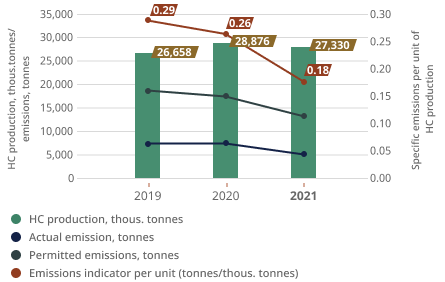Sustainability
- Home
- /
- Sustainability
- /
- Emissions to Air
Emissions to Air
Activity of such industrial enterprises as KPO is always associated with air emissions. High concentration of toxic substances in the air leads to environmental degradation. In this regard, KPO has set the goal to minimize the negative impact of its activities.
KPO manages pollutant emissions into air based on the limits established in the Environmental Emissions Permit. Most emissions are generated as a result of combustion of gas combustion in flares (37%), incinerators (21%), gas turbine units (20%), boilers, process heaters and compressors (12%), as well as from fugitive sources (10%).
In 2021, total air emissions decreased by 37% compared to 2020 and amounted to 4,798 tonnes. The reduction in emissions is mainly due to the absence of well operations in 2021, accompanied by hydrocarbons well flaring. Table below shows data on the permissible and actual KPO’s emissions for the period of 2019 — 2021.
Permitted and actual volumes of pollutants emissions, 2019 — 2021
Annual volume of emissions by pollutants, in tonnes: | 2021 | 2020 | 2019 |
Permitted: | 13,219 | 17,527 | 18,544 |
Actual, including: | 4,798 | 7,591 | 7,597 |
Nitrogen oxides | 1,197 | 1,637 | 1,636 |
Sulphur dioxide | 1,989 | 3,315 | 3,281 |
Carbon monoxide | 1,039 | 1,145 | 1,205 |
Volatile organic compounds | 452 | 1,352 | 1,329 |
H2S | 3 | 3 | 3 |
Solid particles | 71 | 74 | 80 |
Other | 47 | 65 | 63 |
Note: Emission volumes data is provided in accordance with the data of statistical reports «2-TP Air».
In 2021, the specific emissions per unit of production amounted to 0.18 tonnes per 1,000 tonne of hydrocarbons (HC) produced. Reduction in specific emissions in 2021 versus 2020 is attributed to reduction of total emissions, justified lack of work on wells that require hydrocarbon combustion, as well as a shorter operating time of equipment that makes the main contribution to gross emissions.
Volumes of Hydrocarbons production and environmental emissions in 2019-2021





